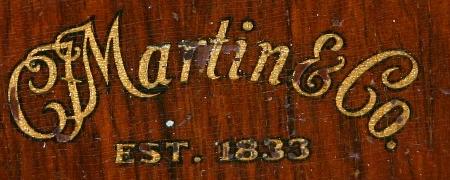
What do George Harrison and Mark Twain have in common? … Both men had Martin Guitars.
In 1833, Christian Frederick Martin established C.F. Martin & Co., as a U.S, guitar producing company. He immigrated to New York City from his native Germany. Today, the sixth generation of the Martin family; Christian F. Martin IV heads the company. He is the Chairman and CEO of Martin Guitars. For over 178 years, a person with the initials, CFM has been in charge of producing what is considered to be one of the finest, if not THE finest steel string guitars in the world.
On a rainy and overcast day in May arriving in Nazareth, Pennsylvania, I had the pleasure of visiting the Martin Guitar factory with my wife Barbara and our friends, Mary & George. What made the journey to Nazareth even more special was that we toured the factory with Chris Martin, Chairman & CEO of the company. Chris graciously showed us around the factory exhibiting both incredible knowledge of how a guitar is properly built and great pride in the workmanship that goes into every musical instrument bearing his family’s name. He treated us to a once in-a-lifetime opportunity to see how this unique company is able to produce musical instruments coveted by every professional (and non-professional) guitar player throughout the world.
At the company’s headquarters in Nazareth, Pa., in the main lobby, there is an entire wall devoted to displaying an excessive amount of album covers devoted to artists that have used Martin Guitars on their records. In some cases, the album cover shows the artist proudly holding a Martin guitar. Johnny Cash, Willie Nelson, Eric Clapton, Crosby, Stills & Nash (individually and collectively), Rick Nelson, Paul Simon, Paul McCartney, Sheryl Crow, Elvis Presley are all represented as artists that have used or currently using Martin guitars including far too many more to mention.
On the other side of the lobby is the Martin Guitar Museum. In it are pictures, vintage guitars and memorabilia devoted to the history and production of these prized possessions. One of the photographs in the museum that caught my eye was a picture taken in February, 1968 through a chain link fence in Rishikesh, India by photographer, Paul Saltzman. It is a picture of John Lennon and Paul Mc Cartney each playing their Martin guitars. Paul is said to be singing “Ob-la-di, Ob-la-da, how the life goes on” John has just joined in and for 15 minutes they just sing those words over and over. Halfway through, they paused and Paul looks up and says “That’s all there is so far, we don’t have any of the words yet.” A moment in musical history.
In October, 2009, a Martin D-28 that was played by Elvis Presley in his last concert in Las Vegas sold at auction for $106,200.
We began the tour by looking at the wood that is used for the Martin guitars. Chris explained that the best wood to be used to build the back and the sides of the guitar is Brazilian Rosewood. He told us that is the wood of choice for the true guitar professional since it is widely acknowledged for creating a superior sounding guitar. Unfortunately, this wood is now very rare. It’s harvesting is closely protected by the Brazilian government and it is actually illegal to cut down these trees without permission. In its place, Rosewood from India and Madagascar is now being used. Rosewood is considered the premier tone wood, but mahogany is also preferred and Martin now uses spruce from Western Canada and southwestern Alaska.
Chris explained that when they cut the wood and take a whole log and cut it in half. They then take that log and cut it in half again to make it in quarters. They slice the veneers out of the quarter and what they are looking for is straight grain that is running through the wood. That is the best way to cut the wood in terms of support and structure for the guitar.
Once the wood is cut, it needs to be put in a temperature controlled room on a palette with sticks in between so that air can circulate. The company is looking to have a 68% moisture content into the wood. It sits in the room at 72 degrees, 45% humidity for two years
D-45: A luxuriously ornamented version of the “D-28.” First made for Gene Autry. Pre-World War II D-45s (only 91 were made) are the most expensive guitars in the United States.
We spent some time looking at the material used for the inlays, called the rosette that is present in virtually all guitars. I was under the impression that ivory was the material used. According to Chris, “years ago they used ivory and tortoise shell, but not anymore.” Yes, the replacement material being used today is plastic, although it does “look like” ivory. Once in a while people will contact Chris and tell him that they have ivory to sell him. He flatly refuses to use that material since the use of ivory is pretty much illegal.
We were told that in the 1930’s, the company went from gut guitar strings to steel strings and that event ushered in the invention and development of the modern western guitar.


No Comments comments associated with this post